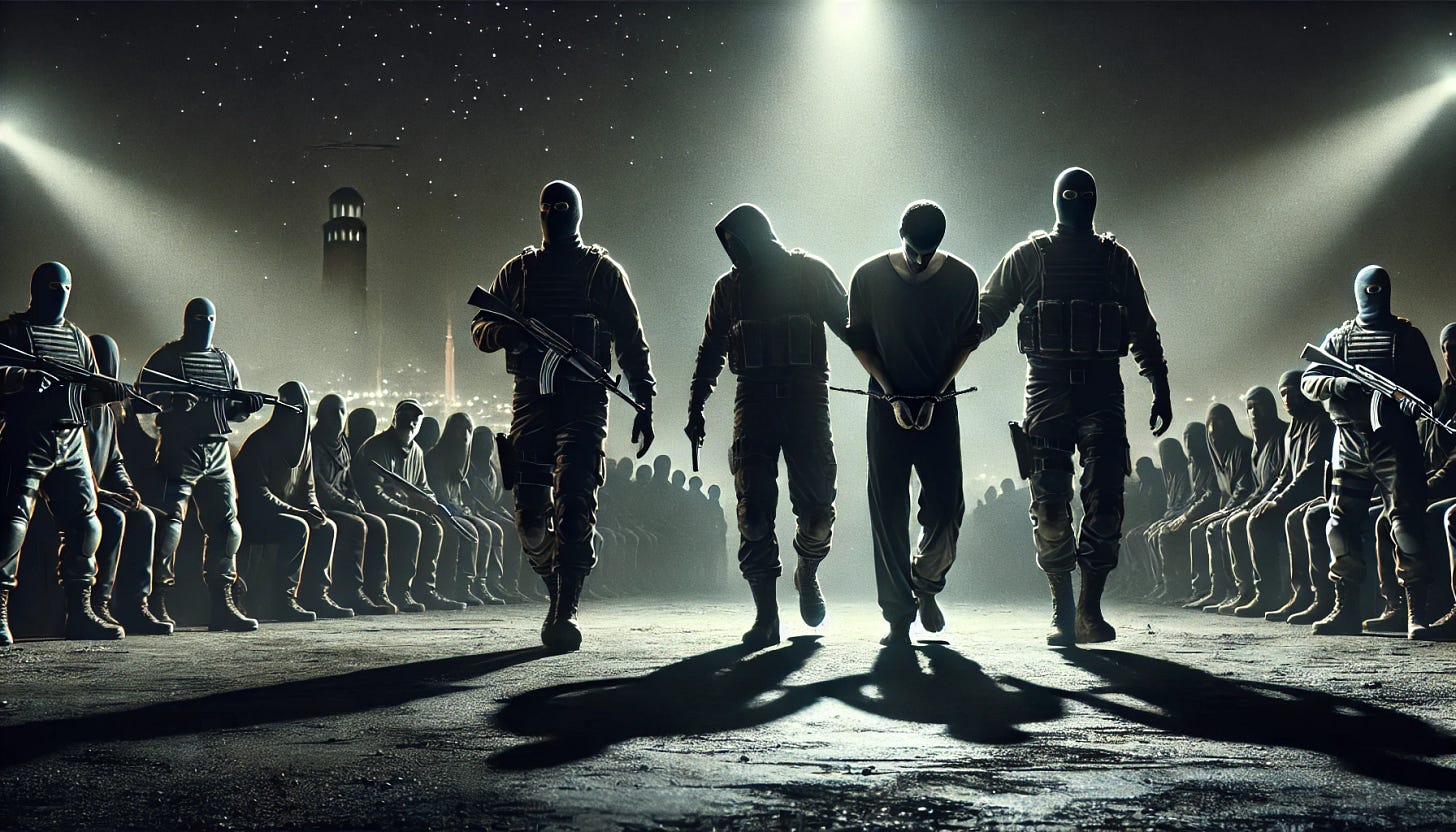Israeli Hostages Released in Hamas Propaganda Ceremony, Resembling Holocaust Survivors
Hamas Further Showcases Its Brutality in Recent Propaganda Ceremony Releasing Israeli Hostages
This past weekend, Hamas released three Israeli hostages—Eli Sharabi, 52; Ohad Ben Ami, 56; and Or Levy, 34—after 16 months in captivity. The exchange, which also saw Israel freeing 183 Palestinian prisoners, was meant to be a significant step in the ongoing ceasefire. However, Hamas exploited the release as a propaganda tool, staging a public spectacle where the frail and starving hostages were forced to thank their captors. The grotesque display has ignited global outrage and further exposed Hamas' inhumane treatment of its captives. The haunting images of the emaciated and frail hostages, resembling skeletal Holocaust survivors, have drawn chilling comparisons to the Muselmann—victims of Nazi death camps who were starved to the brink of death.
Propaganda in Full Display
Hamas' handling of the hostage release was widely condemned as a propaganda stunt. The three Israeli hostages, visibly weak, gaunt, and emaciated, were paraded in a public square in Deir al-Balah, Gaza, before their transfer to the Red Cross. They were made to read scripted statements expressing gratitude to their captors—an ordeal conducted at gunpoint.
Israeli Foreign Minister Gideon Saar likened the scenes to "the worst moments in Jewish history," stating that the images of the starved captives evoked the suffering of Holocaust survivors. President Isaac Herzog called Hamas' actions a "crime against humanity."
Chilling Resemblance to Holocaust Victims
The release of Israeli hostages has sparked widespread outrage, with many comparing their skeletal appearance to the Muselmann—Jewish prisoners in Nazi concentration camps who were starved to the brink of death. The three hostages were visibly exhausted and severely underweight, their protruding bones and sunken faces revealing the extreme malnutrition they endured under Hamas' captivity.
Hamas' deliberate starvation and inhumane treatment of these captives expose the group's calculated cruelty. While they continue to falsely accuse Israel of genocide, their own actions tell a different story—one of systematic abuse, deprivation, and propaganda. The suffering inflicted on these hostages was not incidental but a strategic choice to use them as political pawns.
The Exchange: Hostages for Prisoners
Under the terms of the current ceasefire deal, Hamas agreed to release a total of 25 living Israeli hostages, as well as the bodies of eight others who perished in captivity. In return, Israel has pledged to release over 1,500 Palestinian prisoners, including individuals convicted of terrorism.
So far, 16 Israeli hostages have been freed, alongside approximately 550 Palestinian prisoners. The latest release saw 183 Palestinian detainees returning to Ramallah and Khan Younis, some in visibly deteriorated condition. Seven required immediate hospitalization.
The Stories Behind the Hostages
The three freed Israeli men have harrowing personal stories. Eli Sharabi was abducted from Kibbutz Be’eri on October 7, 2023, during Hamas’ attack on southern Israel. His wife and daughters were killed in their home’s safe room, and his brother Yossi was also taken captive but later confirmed dead. It remains unclear whether Sharabi was informed of his family’s fate before his release.
Or Levy was kidnapped from the Supernova music festival, where Hamas gunmen massacred hundreds. His wife, Einav, was murdered in the attack, leaving behind their now three-year-old son, Almog, who has spent the past 16 months believing his father was simply "missing."
Ohad Ben Ami was also taken from Kibbutz Be’eri. His wife, Raz, was released in a prior hostage exchange, leaving their daughters to campaign tirelessly for his return. Their viral reaction to his release—joyously piling on each other—captured the emotional rollercoaster of relief and pain experienced by many Israeli families.
The Role of Hamas’ Shadow Unit
Military analysts, including FDD Senior Analyst Joe Truzman, pointed out that Hamas' "Shadow Unit"—the faction responsible for managing hostages—played a prominent role in the release. Hamas operatives visibly controlled the stage, reinforcing their authority. Stickers were placed on the Israeli hostages, marking them as captives of Hamas' military wing, the al-Qassam Brigades. A symbolic "Red Triangle" patch appeared on Hamas fighters, a recurring image in the group’s propaganda. Additionally, Hamas orchestrated the signing of a "release certificate," a move widely dismissed as a theatrical stunt meant for the cameras. These intentional acts by Hamas further demonstrate the extent of their propaganda, as they manipulate the suffering of hostages to bolster their own image.
A War of Narratives
The latest hostage release underscores the war of narratives at play in the Israel-Hamas conflict. While Hamas seeks to project strength and resilience, this recent hostage release serves as further evidence of Hamas’ cruelty. For the freed hostages and their families, the moment is bittersweet—a return to freedom but one overshadowed by immense personal loss and trauma.



